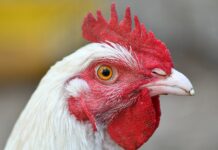MANHATTAN, Kan. — The high cost of fertilizer nutrients is convincing some producers to go to the birds. Poultry, that is.
More specifically, they are turning to poultry waste, or litter. Poultry litter can provide a significant and important supply of nutrients for crop production, said Doug Shoup, Kansas State University Research and Extension Southeast crops and soils specialist.
Poultry litter can serve as an excellent complement to commercial nitrogen fertilizer, but it should not be seen as a complete replacement for commercial nitrogen fertilizer.
Water
Poultry litter has a high phosphorus concentration relative to nitrogen. Poultry litter application rates should be based on phosphorus levels, not nitrogen levels, to avoid potential water contamination problems.
Applications in excess of agronomic needs can lead to high concentrations of phosphorus in surface runoff, leading in turn, to potential contamination of surface water bodies. High nutrient loading into lakes contributes to unwanted algal blooms and eutrophication.
When storing litter, producers should place piles in areas farthest from ditches, waterways, and streams to minimize the potential for runoff into surface waters.
Reduce
Incorporation of litter immediately after application will reduce the potential for volatilization losses and potential loss caused by water runoff in case of a rainfall event. Nutrient concentration in poultry litter can be highly variable and depends mainly upon production conditions, and storage and handling methods.
Therefore, laboratory analysis is the best way to determine the level of nitrogen and phosphorus in the litter. Nitrogen and phosphorus crop availability shortly after application is a common question.
Field and laboratory studies suggest that the fraction of total nitrogen that becomes plant available the first year of application is approximately 45 percent to 55 percent, depending upon components in the litter, and the method of handling and application.
Similar
Phosphorus availability from poultry litter is considered similar to commercial fertilizers. Therefore supplemental phosphorus fertilization after application of poultry litter is unnecessary when litter application rates provide sufficient amounts of phosphorus.
However, it is important to remember that supplemental nitrogen may be required when application rates are based on the phosphorus content of the litter. The use of poultry litter can contribute to a reduced cost of fertilizer inputs for many operations, depending on the price and transportation cost of the litter.
For many farmers the use of poultry litter may represent significant savings.









